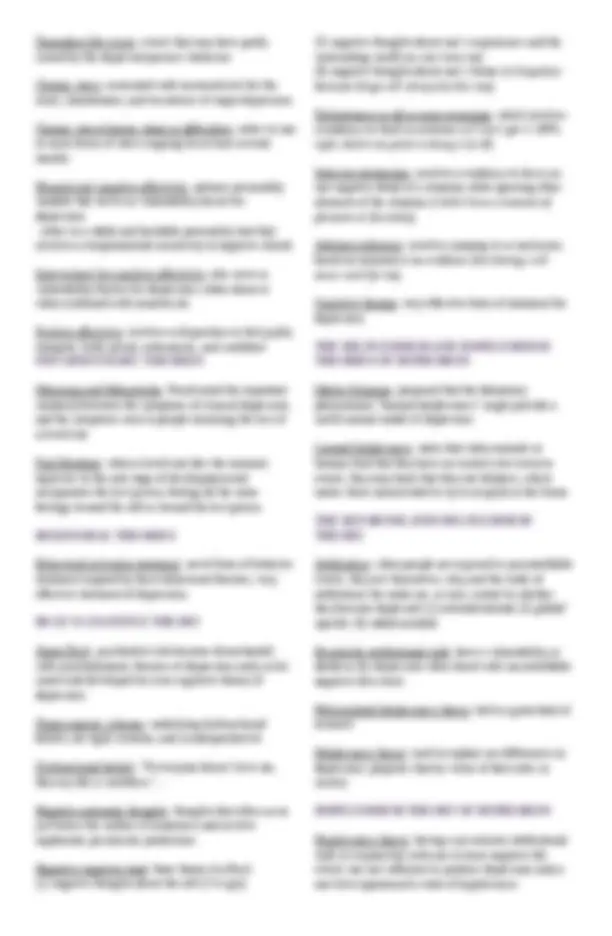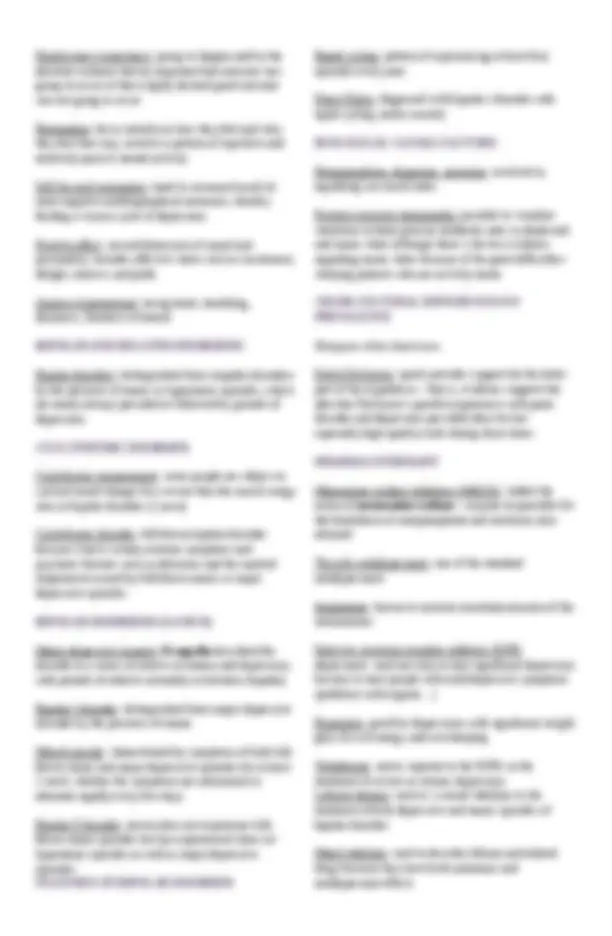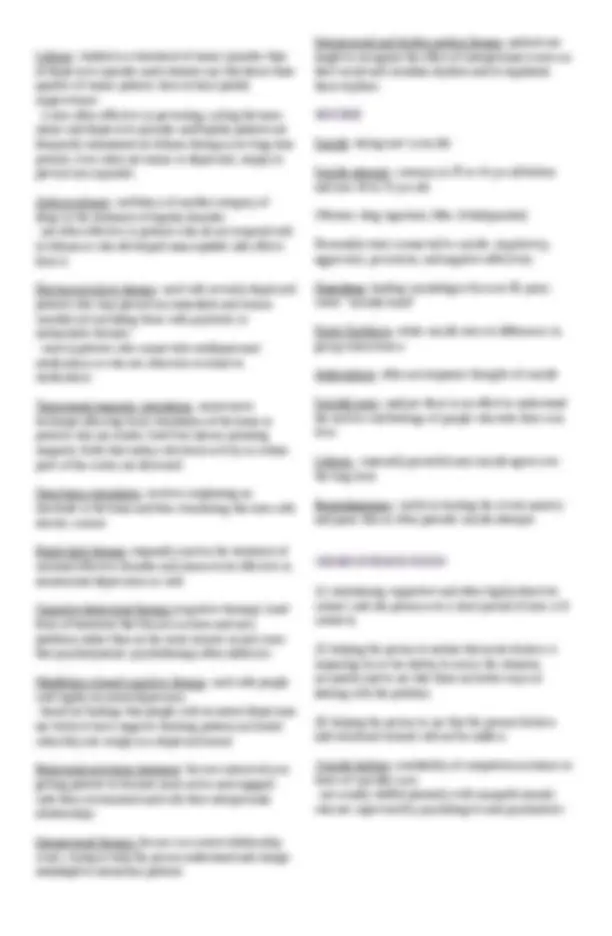





Study with the several resources on Docsity

Earn points by helping other students or get them with a premium plan


Prepare for your exams
Study with the several resources on Docsity

Earn points to download
Earn points by helping other students or get them with a premium plan
Community
Ask the community for help and clear up your study doubts
Discover the best universities in your country according to Docsity users
Free resources
Download our free guides on studying techniques, anxiety management strategies, and thesis advice from Docsity tutors
Chapter 6 Abnormal Psychology Butcher
Typology: Lecture notes
1 / 5

This page cannot be seen from the preview
Don't miss anything!





On special offer
Chapter 6: Mood Disorder and Suicide: Causal factors, theories, and treatment
Mood disorders: involve much more severe alterations in mood for much longer periods of time : disturbances of mood are intense and persistent enough to be clearly maladaptive and often lead to serious problems in relationships and work performance : are diverse in nature, as is illustrated by the many types of depression recognized in the DSM-
Affect: extremes of emotion
Mania: often characterized by intense and unrealistic feelings of excitement and euphoria
Depression: involves feelings of extraordinary sadness and dejection
Manic and depressive mood states: are often conceived to be at opposite ends of a mood continuum, with normal mood in the middle
TYPE OF MOOD DISORDERS
MAJOR DEPRESSIVE DISORDER (MDD)
Unipolar depressive disorders: person experiences only depressive episodes
Bipolar and related disorders: person experiences both manic and depressive episodes ( 2 week period ) (1) depressed mood (2) loss of interest or pleasure
MANIC EPISODE
Manic episode: person shows a markedly elevated, euphoric, or expansive mood, often interrupted by occasional outbursts of intense irritability or even violence – particularly when others refuse to go along with the manic person’s wishes and schemes (at least a week) Hypomanic episode: person experiences abnormally elevated, expansive, or irritable mood ( at least one week)
THE PREVALENCE OF MOOD DISORDERS
Major depressive disorder (MDD): major depressive episodes occur : is the most common and its occurrence has increased
National Comorbidity Survey – Replication (NCS-R): lifetime prevalence rates of unipolar major depression at nearly 17%
Bowlby’s normal response to the loss of a spouse or close family member: (1) numbing and disbelief (2) yearning and searching for the dead person (3) disorganization and despair that sets in when the person accepts the loss as permanent (4) some reorganization as the person gradually begins to rebuild his or her life
Postpartum blues: include changeable mood, crying easily, sadness, and irritability, and often liberally intermixed with happy feelings ( 10 days of the birth of their child )
Dysthymic disorder (persistent depressive disorder/ dysthymia): generally considered to be of mild to moderate intensity, but its primary hallmark is its chronicity ( 4 to 5 years but can persist for 20 yrs )
Major depressive disorder: require that the person exhibit more symptoms than are required for dysthymia and that the symptoms be more persistent ( 2 weeks )
Recurrent episode: preceded by one or more previous episodes
Relapse: refers to the return of symptoms within a fairly short period of time, a situation that probably reflects the fact that the underlying episode of depression has not yet run its course
Specifiers: different patterns of symptoms or features
Major depressive episode with melancholic features: patient has MDD symptoms and has lost interest in almost all activities or does not react to usually pleasurable stimuli or desired events
Severe major depressive episode with psychotic features: psychotic symptoms, characterized by loss of contact with reality and delusions or hallucinations may sometimes accompany other symptoms of major depression
Mood congruent: appropriate to serious depression because the content is negative in tone, such as themes of personal inadequacy, guilt, deserved punishment, death, or disease
Major depressive episode with atypical features: includes a pattern of symptoms characterized by mood reactivity; that is, the person’s mood brightens in response to potential positive events
Monoamine oxidase inhibitors: individuals with atypical features may preferentially respond to a different class of antidepressants than do most other individuals with depression
Major depressive episode with catatonic features: marked with psychomotor disturbances, includes range of psychomotor symptoms, from motoric immobility to extensive psychomotor activity
Catatonia: subtype of schizophrenia; actually more frequent associated with certain forms of depression and mania than with schizophrenia
Recurrent major depressive episode with a seasonal pattern: shows a seasonal pattern
Double depression: moderately depressed on a chronic basis but undergo increased problems from time to time, during which they also meet criteria for a major depressive episode
BIOLOGICAL CAUSAL FACTORS
Hippocrates: who hypothesized that depression was caused by an excess of “black bile” in the system
Serotonin-transporter gene: gene involved in the transmission and reuptake of serotonin
Monoamine theory of depression: the depression was at least sometimes due to an absolute or relative depletion of one or both of these neurotransmitters at important receptor sites in the brain
Anhedonia: inability to experience pleasure; an important symptom of depression
Hypothalamic-pituitary-adrenal (HPA) axis: CORTISOL: excreted by the outermost portion of the adrenal glands and is regulated through a complex feedback loop
Dexamethasone: potent suppressor of plasma cortisol in normal individuals
Hypothalamic-pituitary-thyroid axis: disturbances to this axis are also linked to mood disorders
Hypothyroidism: people with low thyroid levels
Anterior prefrontal cortex: damage to the left often leads to depression
Orbital prefrontal cortex: several regions of the prefrontal cortex which is involved in responsivity to rewards show decreased volume in individuals with recurrent depression relative to normal controls
Dorsolateral prefrontal cortex: associated with decreased cognitive control, have also been observed in individuals with depression compared to controls
Hippocampus: critical to learning and memory and regulation of adrenocorticotrophic hormone
Anterior cingulated cortex: shows decreased volume and abnormally low levels of activation in patients with depression; area involved in selective attention
Amygdala: involved in the perception of threat and in directing attention to show increased activation in individuals with depression and may be related to their biased attention to negative emotional information Sleep: characterized by five stages that occur in relatively invariant sequence throughout the night
Rapid eye movement sleep: characterized by rapid eye movements and dreaming as well as other bodily changes
Suprachiasmatic nucleus: regulates sleep-wake cycle
Circadian rhythms: circadian (24hrs or daily); bodily temperature, propensity to REM sleep, secretion of cortisol, thyroid-stimulating hormone, and growth hormone
Central oscillators: biological clocks
Seasonal affective disorder: most of those affected seem to be responsive to the total quantity of available light in the environment
PSYCHOLOGICAL CAUSAL FACTORS
Psychological stressors: known to be involved in the onset of a variety of disorders
Independent life events: losing a job bc of shutdown…
Hopelessness expectancy: going to happen and by the absolute certainty that an important bad outcome was going to occur or that a highly desired good outcome was not going to occur
Rumination: focus intently on how they feel and why they feel that way; involves a pattern of repetitive and relatively passive mental activity
Self-focused rumination: leads to increased recall of more negative autobiographical memories, thereby feeding a vicious cycle of depression
Positive affect: second dimension of mood and personality; includes affective states such as excitement, delight, interest, and pride
Anxious hyperarousal: racing heart, trembling, dizziness, shortness of breath
BIPOLAR AND RELATED DISORDERS
Bipolar disorders: distinguished form unipolar disorders by the presence of manic or hypomanic episodes, which are nearly always preceded or followed by periods of depression
CYCLOTHYMIC DISORDER
Cyclothymic temperament: some people are subject to cyclical mood changes less severe than the mood swings seen in bipolar disorder ( 2 years )
Cyclothymic disorder: full-blown bipolar disorder because it lacks certain extreme symptoms and psychotic features such as delusions and the marked impairment caused by full-blown manic or major depressive episodes
BIPOLAR DISORDERS (I AND II)
Manic-depressive insanity: Kraepelin described the disorder as a series of attacks of elation and depression, with periods of relative normality in between (bipolar)
Bipolar I disorder: distinguished form major depressive disorder by the presence of mania
Mixed episode: characterized by symptoms of both full- blown manic and major depressive episodes for at least 1 week, whether the symptoms are intermixed or alternate rapidly every few days
Bipolar II disorder: person does not experience full- blown manic episodes but has experienced clear-cut hypomanic episodes as well as major depressive episodes FEATURES OF BIPOLAR DISORDER
Rapid cycling: pattern of experiencing at least four episodes every year
Ernest Eaton: diagnosed with bipolar i disorder with rapid cycling (roller coaster)
BIOLOGICAL CAUSAL FACTORS
Norepinephrine, dopamine, serotonin: involved in regulating our mood states
Positron emission tomography: possible to visualize variations in brain glucose metabolic rates in depressed and manic states although there is far less evidence regarding manic states because of the great difficulties studying patients who are actively manic
CROSS-CULTURAL DIFFERENCES IN PREVALENCE
European white Americans
Emily Dickinson: (poet) provides support for the latter part of this hypothesis – that is, evidence supports the idea that Dickinson’s painful experiences with panic disorder and depression provided ideas for her especially high-quality work during those times
PHARMACOTHERAPY
Monoamine oxidase inhibitors (MAOIs): inhibit the action of monoamine oxidase – enzyme responsible for the breakdown of norepinephrine and serotonin once released
Tricyclic antidepressants: one of the standard antidepressants
Imipramine: known to increase neurotransmission of the monoamines
Selective serotonin reuptake inhibitor (SSRI) depressants: used not only to treat significant depression but also to treat people with mild depressive symptoms (problems with orgasm…)
Bupropion: good for depressions with significant weight gain, loss of energy, and oversleeping
Venlafaxine: seems superior to the SSRIs in the treatment of severe or chronic depression Lithium therapy: used as a mood stabilizer in the treatment of both depressive and manic episodes of bipolar disorder
Mood stabilizer: used to describe lithium and related drugs because they have both antimanic and antidepressant effects
Lithium: studied as a treatment of manic episodes than of depressive episodes and estimates are that about three quarters of manic patients show at least partial improvement : is also often effective in preventing cycling between manic and depressive episodes and bipolar patients are frequently maintained on lithium therapy over long time periods, even when not manic or depressed, simply to prevent new episodes
Anticonvulsants: usefulness of another category of drugs in the treatment of bipolar disorder : are often effective in patients who do not respond well to lithium or who developed unacceptable side effects from it
Electroconvulsive therapy: used with severely depressed patients who may present an immediate and serious suicidal risk including those with psychotic or melancholic features : used in patients who cannot take antidepressant medications or who are otherwise resistant to medications
Transcranial magnetic stimulation: noninvasive technique allowing focal stimulation of the brain in patients who are awake; brief but intense pulsating magnetic fields that induce electrical activity in certain parts of the cortex are delivered
Deep brain stimulation: involves implanting an electrode in the brain and then stimulating that area with electric current
Bright light therapy: originally used in the treatment of seasonal effective disorder and shown to be effective in nonseasonal depressions as well
Cognitive-behavioral therapy (cognitive therapy): brief form of treatment that focuses on here-and-now problems rather than on the more remote casual issues that psychodynamic psychotherapy often addresses
Mindfulness-based cognitive therapy: used with people with highly recurrent depression : based on findings that people with recurrent depression are likely to have negative thinking patterns activated when they are simply in a depressed mood
Behavioral activation treatment: focuses intensively on getting patients to become more active and engaged with their environment and with their interpersonal relationships
Interpersonal therapy: focuses on current relationship issues, trying to help the person understand and change maladaptive interaction patterns
Interpersonal and rhythm pattern therapy: patients are taught to recognize the effect of interpersonal events on their social and circadian rhythms and to regularize these rhythms
SUICIDE
Suicide: taking one’s own life
Suicide attempts: common in 25 to 44 yrs old before and now 18 to 24 yrs old
(Women: drug ingestion; Men: lethal/gunshot)
Personality traits connected to suicide: impulsivity, aggression, pessimism, and negative affectivity
Shneidman: leading suicidologist for over 35 years; wrote “suicidal mind”
Emile Durkheim: relate suicide rates to differences in group cohesiveness
Ambivalence: often accompanies thoughts of suicide
Suicidal notes: analyze these in an effort to understand the motives and feelings of people who take their own lives
Lithium : especially powerful anti-suicide agent over the long term
Benzodiazepines: useful in treating the severe anxiety and panic that so often precede suicide attempts
(1) maintaining supportive and often highly directive contact with the person over a short period of time (1- contacts)
(2) helping the person to realize that acute distress is impairing his or her ability to assess the situation accurately and to see that there are better ways of dealing with the problem
(3) helping the person to see that the present distress and emotional turmoil will not be endless
Suicide hotlines: availability of competent assistance at times of suicidal crisis : are usually staffed primarily with nonprofessionals who are supervised by psychologists and psychiatrists